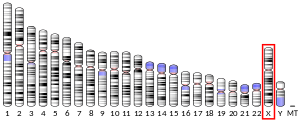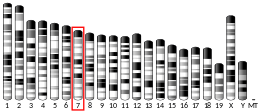CLCN4
H(+)/Cl(-) exchange transporter 4 is a protein that in humans is encoded by the CLCN4 gene.[5][6]
Function
The CLCN family of voltage-dependent chloride channel genes comprises nine members (CLCN1-7, Ka and Kb) which demonstrate quite diverse functional characteristics while sharing significant sequence homology. Chloride channel 4 has an evolutionary conserved CpG island and is conserved in both mouse and hamster. This gene is mapped in close proximity to APXL (Apical protein Xenopus laevis-like) and OA1 (Ocular albinism type I), which are both located on the human X chromosome at band p22.3. The physiological role of chloride channel 4 remains unknown but may contribute to the pathogenesis of neuronal disorders.[6]
Clinical significance
Mutations in this gene have been linked to cases of early onset epilepsy[7]
See also
References
- GRCh38: Ensembl release 89: ENSG00000073464 - Ensembl, May 2017
- GRCm38: Ensembl release 89: ENSMUSG00000000605 - Ensembl, May 2017
- "Human PubMed Reference:". National Center for Biotechnology Information, U.S. National Library of Medicine.
- "Mouse PubMed Reference:". National Center for Biotechnology Information, U.S. National Library of Medicine.
- van Slegtenhorst MA, Bassi MT, Borsani G, Wapenaar MC, Ferrero GB, de Conciliis L, Rugarli EI, Grillo A, Franco B, Zoghbi HY, Ballabio A (Sep 1994). "A gene from the Xp22.3 region shares homology with voltage-gated chloride channels". Hum Mol Genet. 3 (4): 547–52. doi:10.1093/hmg/3.4.547. PMID 8069296.
- "Entrez Gene: CLCN4 chloride channel 4".
- Veeramah KR, Johnstone L, Karafet TM, Wolf D, Sprissler R, Salogiannis J, Barth-Maron A, Greenberg ME, Stuhlmann T, Weinert S, Jentsch TJ, Pazzi M, Restifo LL, Talwar D, Erickson RP, Hammer MF (2013). "Exome sequencing reveals new causal mutations in children with epileptic encephalopathies". Epilepsia. 54 (7): 1270–81. doi:10.1111/epi.12201. PMC 3700577. PMID 23647072.
Further reading
- Schnur RE, Wick PA (1995). "Intragenic TaqI restriction fragment length polymorphism (RFLP) in CICN4, between the loci for X-linked ocular albinism (OA1) and microphthalmia with linear skin defects syndrome (MLS)". Hum. Genet. 95 (5): 594–5. doi:10.1007/BF00223880. PMID 7759088.
- Maruyama K, Sugano S (1994). "Oligo-capping: a simple method to replace the cap structure of eukaryotic mRNAs with oligoribonucleotides". Gene. 138 (1–2): 171–4. doi:10.1016/0378-1119(94)90802-8. PMID 8125298.
- Dinulos MB, Bassi MT, Rugarli EI, Chapman V, Ballabio A, Disteche CM (1996). "A new region of conservation is defined between human and mouse X chromosomes". Genomics. 35 (1): 244–7. doi:10.1006/geno.1996.0347. PMID 8661129.
- Suzuki Y, Yoshitomo-Nakagawa K, Maruyama K, Suyama A, Sugano S (1997). "Construction and characterization of a full length-enriched and a 5'-end-enriched cDNA library". Gene. 200 (1–2): 149–56. doi:10.1016/S0378-1119(97)00411-3. PMID 9373149.
- Lamb FS, Clayton GH, Liu BX, Smith RL, Barna TJ, Schutte BC (1999). "Expression of CLCN voltage-gated chloride channel genes in human blood vessels". J. Mol. Cell. Cardiol. 31 (3): 657–66. doi:10.1006/jmcc.1998.0901. PMID 10198195.
- Kawasaki M, Fukuma T, Yamauchi K, Sakamoto H, Marumo F, Sasaki S (1999). "Identification of an acid-activated Cl(-) channel from human skeletal muscles". Am. J. Physiol. 277 (5 Pt 1): C948–54. PMID 10564087.
- Wang T, Weinman SA (2004). "Involvement of chloride channels in hepatic copper metabolism: ClC-4 promotes copper incorporation into ceruloplasmin". Gastroenterology. 126 (4): 1157–66. doi:10.1053/j.gastro.2004.01.015. PMID 15057754.
- Suzuki Y, Yamashita R, Shirota M, Sakakibara Y, Chiba J, Mizushima-Sugano J, Nakai K, Sugano S (2004). "Sequence Comparison of Human and Mouse Genes Reveals a Homologous Block Structure in the Promoter Regions". Genome Res. 14 (9): 1711–8. doi:10.1101/gr.2435604. PMC 515316. PMID 15342556.
- Picollo A, Pusch M (2005). "Chloride/proton antiporter activity of mammalian CLC proteins ClC-4 and ClC-5". Nature. 436 (7049): 420–3. doi:10.1038/nature03720. PMID 16034421.
- Huang L, Cao J, Wang H, Vo LA, Brand JG (2006). "Identification and Functional Characterization of a Voltage-gated Chloride Channel and Its Novel Splice Variant in Taste Bud Cells". J. Biol. Chem. 280 (43): 36150–7. doi:10.1074/jbc.M507706200. PMC 2367165. PMID 16129671.
- Littler DR, Assaad NN, Harrop SJ, Brown LJ, Pankhurst GJ, Luciani P, Aguilar MI, Mazzanti M, Berryman MA, Breit SN, Curmi PM (2005). "Crystal structure of the soluble form of the redox-regulated chloride ion channel protein CLIC4". FEBS J. 272 (19): 4996–5007. doi:10.1111/j.1742-4658.2005.04909.x. PMID 16176272.
- Okkenhaug H, Weylandt KH, Carmena D, Wells DJ, Higgins CF, Sardini A (2006). "The human ClC-4 protein, a member of the CLC chloride channel/transporter family, is localized to the endoplasmic reticulum by its N-terminus". FASEB J. 20 (13): 2390–2. doi:10.1096/fj.05-5588fje. PMID 17023393.
External links
- CLCN4+protein,+human at the US National Library of Medicine Medical Subject Headings (MeSH)
- Human CLCN4 genome location and CLCN4 gene details page in the UCSC Genome Browser.
This article incorporates text from the United States National Library of Medicine, which is in the public domain.





